Weekly Advanced Technologies〔64〕

Weekly Advanced Technologies〔64〕丨Official Announcement! The "Magic Artifact" to Penetrate the Mysteries of the World Has Been Created 丨Alternation between "Accelerator" and "Brake": The Wisdom of Plants in Regulating Growth and Development
Hyperspectral imaging technology is capable of simultaneously obtaining the spatial structure information of the target as well as the spectral information of tens or even hundreds of bands. This enables accurate identification of the material characteristics of the target and recognition within complex environments.
The team led by ZHANG Jun at Beijing Institute of Technology has independently developed a 100-channel megapixel hyperspectral real-time imaging device. This device is developed to meet the requirements for intelligent and lightweight detection in new-mass and new-domain applications in the future. The device will increase the light energy utilization rate from the typical less than 25% to 74.8%, setting a new world-record high.
"How do plants regulate growth and development? How do they adapt to environmental changes?" Science magazine listed this as one of the 125 great scientific questions unknown to mankind. Recently, scientists at the Institute of Genetics and Development Biology, Chinese Academy of Sciences (IGDBS) have provided answers.
Based on the weekly diary of technology provided by the daily list of the NCSTI online service platform, we launch the column "Weekly Advanced Technologies" at the hotlist of sci-tech innovation. Today, let's check out No.64.
1. Nature丨Official Announcement! The "Magic Artifact" to Penetrate the Mysteries of the World Has Been Created
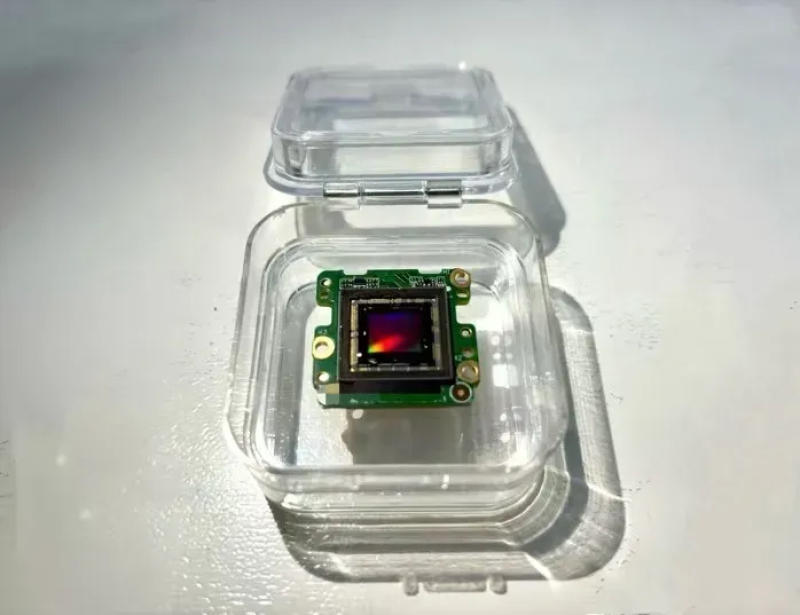
Novel Hyperspectral Intelligent Imaging Devices
Hyperspectral imaging technology is able to simultaneously obtain the spatial structure information of a target and spectral information within tens or even hundreds of wavelength bands, which can precisely identify the material characteristics of the target and recognize complex environments. The data generated by hyperspectral imaging is of a huge scale. For a long time, this technology has largely depended on the operation of complex optical systems made up of discrete components like gratings and prisms. These systems are large in size, difficult to integrate, and have low resolution and optical energy utilization.
In this regard, in view of the future intelligent and lightweight detection requirements for new-mass and new-domain applications, the ZHANG Jun team from Beijing Institute of Technology, through multidisciplinary cross-research in materials, electronics, optics, computer science and other fields, has independently developed a 100-channel megapixel hyperspectral real-time imaging device. This device can increase the light energy utilization rate from typically less than 25% to 74.8%, setting a world-record high.
This device is small in size (29 mm × 29 mm × 42 mm), light in weight (46 grams), and highly intelligent. It can perform real-time hyperspectral imaging and accurate target identification, achieving high-resolution spectral imaging in the visible-near-infrared band. In the 400-1000 nm band range, the spectral resolution reaches 2.65 nm, and the spatio-temporal resolution is 2048 × 2048 @ 47fps; in the 400-1700 nm band range, the spectral resolution is 8.53 nm, and the spatio - temporal resolution is 1024 × 1024 @ 124fps. This device also has a relatively high imaging signal-to-noise ratio (40.2 dB), dynamic range (68.71 dB) and thermal stability (- 60°C - 50°C).
This device has shown broad application prospects in fields such as remote-sensing detection, life and health, smart agriculture, and industrial automation. In the field of remote-sensing detection, the team used this device to shoot high-definition spectral videos of the lunar surface, achieving dynamic remote monitoring of observation targets in a low-light environment, demonstrating the excellent light-energy utilization rate and spatio-temporal-spectral resolution of this device; in the field of life and health, this device has achieved dynamic blood-oxygen detection and water-quality pollution analysis; in the area of smart agriculture, this device has achieved high-precision chlorophyll detection, sugar-content detection, and fruit-bruise detection; in terms of industrial automation, this device has achieved high-precision automatic sorting of textiles.
2. Cell丨Alternation between "Accelerator" and "Brake":The Wisdom of Plants in Regulating Growth and Development
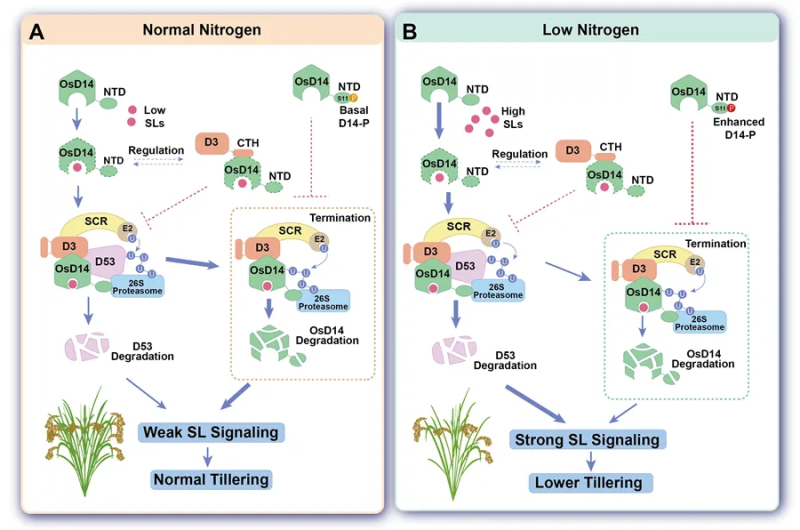
Modeling of rice solanum lactone signaling and its role in low nitrogen tolerance
"How do plants regulate growth and development? How do they adapt to environmental changes?" Science magazine listed this as one of the 125 great scientific questions unknown to mankind. Recently, scientists at the Institute of Genetics and Development Biology, Chinese Academy of Sciences have provided answers.
Strigolactones, an important plant hormone discovered in recent years, are crucial for regulating the number of branches (i.e., tillers), which is a key characteristic in plant growth and development. Wang Bing, a young researcher in Li's team at the Institute of Genetics and Developmental Biology, Chinese Academy of Sciences, has discovered the signaling mechanism of the plant hormone strigolactone and its key role in nitrogen response.
He has also elucidated how plants regulate the "accelerator" and "brake" in the strigolactone signaling pathway and how these mechanisms in the strigolactone signaling pathway can be utilized to control plant growth and development. This study demonstrates how plants can regulate the duration and intensity of strigolactone signaling in different environments by adjusting the "accelerator" and "brake" in the strigolactone signaling pathway in an intelligent and flexible manner, thereby altering the plant type.
In order to analyze the key mechanisms of monocotyledon signaling, the researchers analyzed the amino acid sites that play crucial roles in the interaction among D14, D3, and D53 proteins. Subsequently, based on biochemical and genetic data, they revealed that in the monocotyledon signaling model, D3 has two topological conformations. Their study demonstrated that changing the phosphorylation state of D14 can reduce nitrogen fertilizer input without decreasing tillering. This finding has guiding significance for the precise improvement of crop plant types and the molecular-design breeding of new rice varieties with reduced fertilizer use and increased yield.
3. Science China Physics, Mechanics & Astronomy丨The Einstein Probe Travels through the Starry Sky, Capturing the Ephemeral "Firework" Marvels in the Universe.
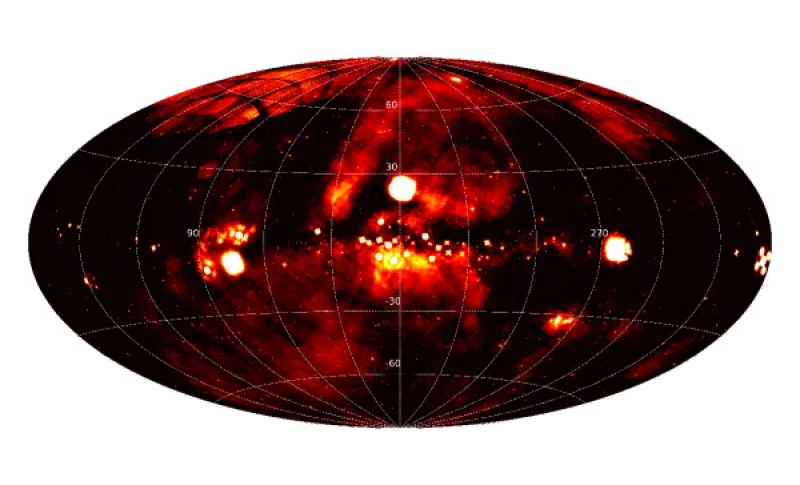
First all-sky X-ray map obtained by the Einstein Probe (Gindo coordinate system)
Transient objects are like ephemeral "fireworks" in the universe, lasting from less than a second to several years. These spectacular and magical celestial phenomena bear crucial information regarding the formation and evolution of celestial bodies, and serve as an important window for scientists to study the extreme phenomena in the universe and explore its mysteries.
The Einstein Probe was successfully launched on January 9th of this year and has been conducting regular scientific operations since July. It has detected various types of transient celestial objects, captured several instances of possible new types of transient sources, and managed to obtain the first all-sky X-ray maps observed by China-developed equipment.
The Einstein Probe is one of the space science satellite missions implemented by the Chinese Academy of Sciences under the Space Science Pilot Project (Phase II). Equipped with the Wide-field X-ray Telescope (WXT) and the Follower X-ray Telescope (FXT) on board, the satellite has performed well in the six-month in-orbit test and exceeded the design expectations. The WXT and FXT have performed well during six months of in-orbit testing, exceeding design expectations. Compared with internationally available equipment in the same field, the detection sensitivity and spatial resolution of the satellite have been improved by more than one order of magnitude.
During the initial testing and operation phase, the Einstein Probe satellite has detected 60 confirmed transient objects, thousands of transient object candidates, over 480 stellar outbursts, and hundreds of outbursts of known objects. The Einstein Probe satellite team has issued more than 100 astronomical alerts to the international astronomical community, guiding international follow-up observations using ground-based and space-based multi-band equipment. The X-ray outbursts detected by the satellite are highly diverse, involving stars, white dwarfs, neutron stars, black holes of different masses, gamma-ray bursts, supernovae, etc. The duration of the radiation varies from tens of seconds to several months, spanning six orders of magnitude.
EP has detected approximately 40 transient objects from the depths of the universe. Transient objects are like ephemeral “fireworks” in the universe. They emerge suddenly and vanish without a trace after a period that ranges from less than a second to several years. These spectacular and miraculous celestial phenomena carry crucial information about the formation and evolution of celestial bodies and serve as an important window for scientists to study the extreme phenomena in the universe and explore its mysteries.
On April 8, 2024, EP discovered a transient celestial body EP240408a and recorded a violent outburst of its X-ray. The brightness of this outburst increased by 300 times and lasted only 12 seconds. Subsequently, the X - ray celestial body disappeared approximately 10 days later. Such transient sources with medium-time scales rarely appeared in previous observations. The spectral and time-varying characteristics of this celestial body are not completely consistent with the currently known types of celestial bodies, indicating that it may belong to a previously unknown category of transient celestial bodies. This discovery has important scientific value for expanding the understanding of the transient celestial body population in the universe and for understanding extreme physical processes.
4. Sleep Medicine Reviews丨Wonderful Tips for Insomnia
One-third of a person's life is spent on sleep. Studies have indicated that there exist neural nuclei and neural circuits in the central nervous system that can induce sleep and promote wakefulness. These are regulated by homeostasis and circadian rhythms and are also affected by external physical and chemical factors such as light, sound, odor, temperature, electricity, and magnetism.
With the acceleration of industrialization, intensifying social competition, increasing work pressure, a growing aging population, and the prevalence of poor lifestyles resulting from the information society, the global incidence of insomnia has been continuously rising in recent years and has shown a tendency towards generalization and a younger age of onset.
HUANG Zhili's research team at Fudan University investigated the effects of physical and chemical factors such as light, temperature, and odor on sleep and wakefulness and their mechanisms, and found that several brain nuclei such as the ventral anterior papillary nucleus, superior colliculus, and dorsal medial hypothalamus, as well as olfactory processing regions such as the olfactory bulb and olfactory tubercle, are involved in the regulation of sleep and wakefulness by different physical and chemical stimuli.
Recently, they published a review article, which summarizes the results of 200 studies conducted over the past decades, to clarify the roles and mechanisms of various physical and chemical factors in the environment on sleep and wakefulness. This review highlights the potential application of external physical and chemical stimuli in the treatment of clinical sleep disorders and provides new insights into how the brain responds to various physical and chemical stimuli and interacts with the sleep-wake regulatory system.
5. Light: Science & Applications丨The Fluorescent EPD Embarks on a New Era for Anti-Counterfeiting Technology
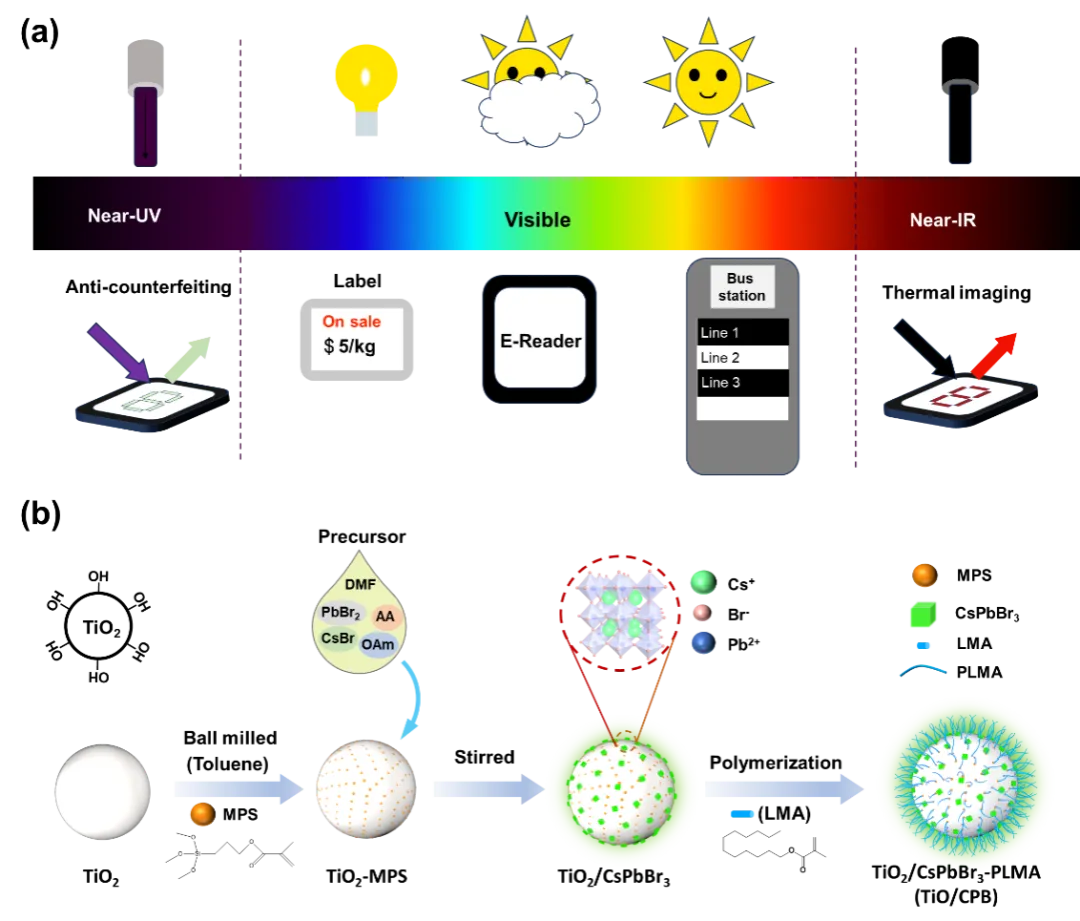
Application scenarios of fluorescent electrophoretic display devices and schematic diagram of preparation of fluorescent electrophoretic particles
Anti-counterfeiting technology plays a crucial role in preventing counterfeit products and safeguarding confidential information, and it is widely applied in product labels, passports, and confidential documents. Electrophoretic display devices (EPDs) are ideal for dynamic anti-counterfeiting technology on account of their low power consumption, ability to switch dynamic images, and high environmental contrast. Fluorescent electrophoretic display technology, in contrast, enables EPDs to function normally under ultraviolet (UV) light, thus expanding the application potential of traditional EPDs in UV-light scenarios. Meanwhile, by combining the two display modes of reflection and emission, multi-mode dynamic anti-counterfeiting applications can be achieved.
The research team innovatively compounded CsPbBr₃ onto TiO₂ electrophoretic particles to prepare a fluorescent electrophoretic particle that appears white under ambient light and green under UV light. Through combination with TiO₂ particles, the composite particle features high charge, high whiteness and a strong fluorescence effect, and can achieve fast-response driving in an electric field.
Based on this material, the research team further developed a fluorescent EPD device, which has a fast response time of 350 ms and a high contrast ratio of 17. Meanwhile, the fluorescent EPD was driven in dual mode by electric field and ultraviolet light, successfully realizing the multi-functional anti-counterfeit display of the device. The fluorescent EPD can display black-and-white state switching under visible light and green-and-white state switching under UV illumination, demonstrating excellent optical anti-counterfeiting performance.
6. Science丨Discovery of Brand-New Dipole Excitons in 2D Semiconductors: Solving the Detection Dilemma
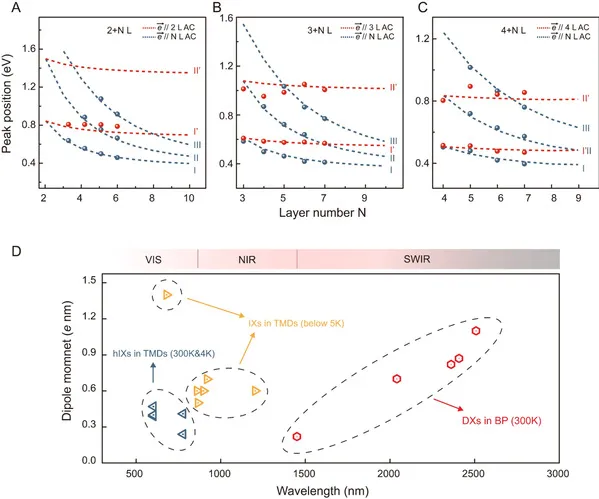
Layer dependence of dipole exciton resonance energies. (A)-(C) Resonance energies of dipole excitons in different combinations of layers. (D) Distribution of resonance energies and electric dipole moment sizes of dipole excitons in two-dimensional van der Waals heterojunctions and homojunctions.
Excitons are capable of exerting a significant influence on the physical properties of two - dimensional semiconductor materials, and they have become one of the most vigorously researched frontiers in the field of two - dimensional materials. Dipole excitons, owing to their electron-hole separation characteristics, are important research targets in the field of condensed matter physics; however, they have been difficult to be observed hitherto.
The team of YAN Huken of the Department of Physics and HUANG Shenyang of the Institute of Optoelectronics Research at Fudan University, along with collaborators, have discovered a novel dipole exciton in artificially stacked black phosphorus homojunctions rotating at an angle of 90°. This type of exciton does not need to rely on the tunneling effect and naturally has a strong ability to interact with light. Even its optical absorption rate at room temperature exceeds 1% and can be easily detected by infrared absorption spectroscopy. This exciton has a fixed electric dipole moment, and at the same time, due to the partial overlap of the electron-hole wave functions, it also exhibits a remarkable ability to interact with light. This characteristic effectively resolves the problem of detection difficulty that has long plagued the research on dipole excitons.
The newly-discovered dipole excitons also offer researchers an unprecedented regulatory dimension. Traditional interlayer excitons have a fixed orientation of the electric dipole moment. However, for the new exciton system, the Fudan team was able to selectively excite dipole excitons in a specific orientation by changing the polarization direction of the incident light. Researchers can also regulate the resonance energy of excitons and the magnitude of the electric dipole moment within a wide range by changing the layer thickness or selecting different inter-band transitions. These excitons are distributed in the infrared band, while conventional dipole excitons are mostly concentrated in the visible range, which significantly expands the working band of dipole excitons.
The “novel” characteristics of dipole excitons not only help promote the research and development of new infrared optoelectronic devices such as low-dimensional photodetectors, micro-spectrometers, and tunable light-emitting devices, but also provide more degrees of freedom for regulating exciton-exciton interactions, which is of great significance for the research in fields such as many-body physics, strongly-correlated quantum states, and nonlinear exciton polaritons. In addition, this research also lays an experimental foundation for exploring the novel quantum phenomena of rectangular moiré superlattices in black phosphorus.
Columnist: Li Xiaoxiao
Translator: Liu Kaiyuan